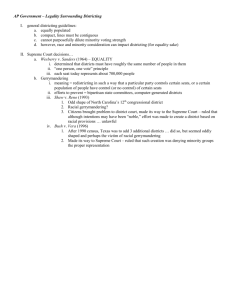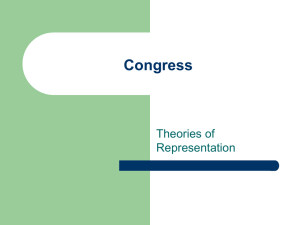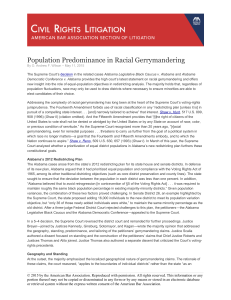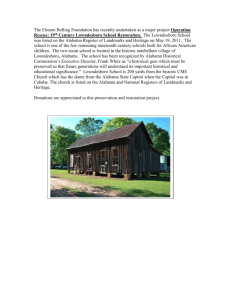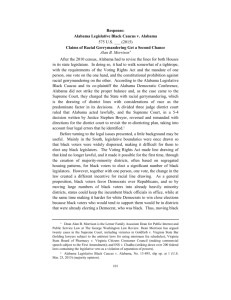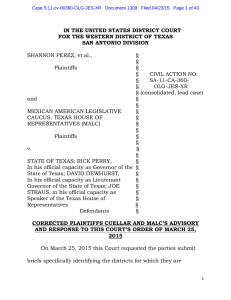Court Sides With Challenge to Alabama s Racial Gerrymander
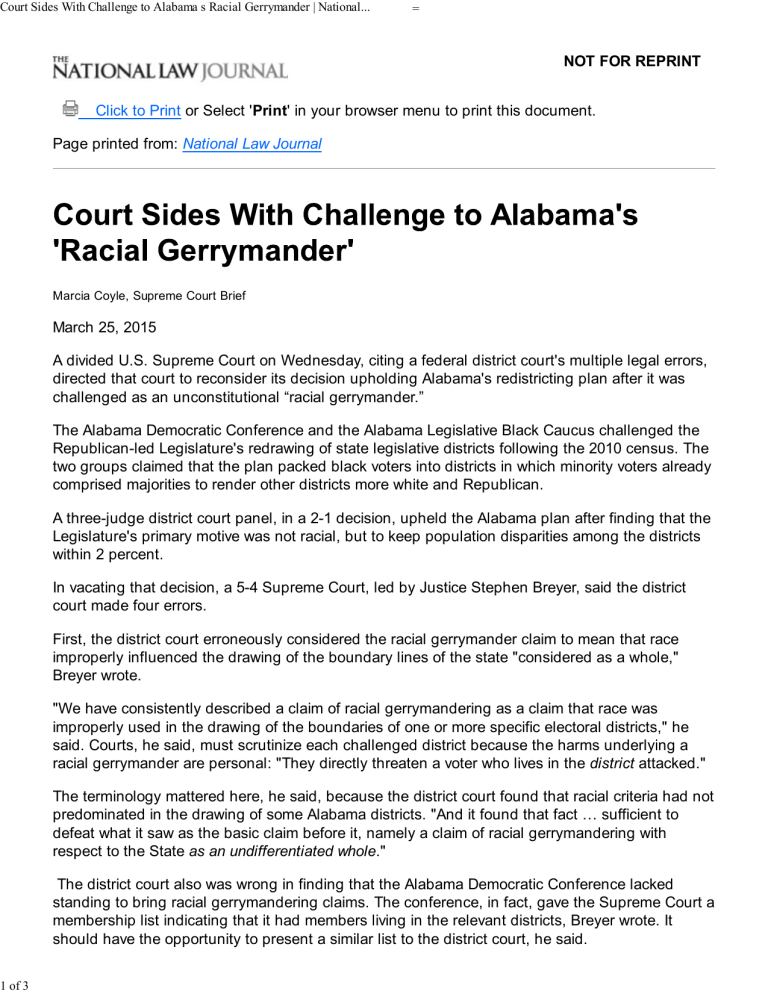
Court Sides With Challenge to Alabama s Racial Gerrymander | National...
=
NOT FOR REPRINT
Click to Print or Select ' Print ' in your browser menu to print this document.
Page printed from: National Law Journal
1 of 3
Marcia Coyle, Supreme Court Brief
March 25, 2015
A divided U.S. Supreme Court on Wednesday, citing a federal district court's multiple legal errors, directed that court to reconsider its decision upholding Alabama's redistricting plan after it was challenged as an unconstitutional “racial gerrymander.”
The Alabama Democratic Conference and the Alabama Legislative Black Caucus challenged the
Republican-led Legislature's redrawing of state legislative districts following the 2010 census. The two groups claimed that the plan packed black voters into districts in which minority voters already comprised majorities to render other districts more white and Republican.
A three-judge district court panel, in a 2-1 decision, upheld the Alabama plan after finding that the
Legislature's primary motive was not racial, but to keep population disparities among the districts within 2 percent.
In vacating that decision, a 5-4 Supreme Court, led by Justice Stephen Breyer, said the district court made four errors.
First, the district court erroneously considered the racial gerrymander claim to mean that race improperly influenced the drawing of the boundary lines of the state "considered as a whole,"
Breyer wrote.
"We have consistently described a claim of racial gerrymandering as a claim that race was improperly used in the drawing of the boundaries of one or more specific electoral districts," he said. Courts, he said, must scrutinize each challenged district because the harms underlying a racial gerrymander are personal: "They directly threaten a voter who lives in the district attacked."
The terminology mattered here, he said, because the district court found that racial criteria had not predominated in the drawing of some Alabama districts. "And it found that fact … sufficient to defeat what it saw as the basic claim before it, namely a claim of racial gerrymandering with respect to the State as an undifferentiated whole ."
The district court also was wrong in finding that the Alabama Democratic Conference lacked standing to bring racial gerrymandering claims. The conference, in fact, gave the Supreme Court a membership list indicating that it had members living in the relevant districts, Breyer wrote. It should have the opportunity to present a similar list to the district court, he said.
Court Sides With Challenge to Alabama s Racial Gerrymander | National...
Third, even if race was a consideration in drawing district boundaries, the lower court found that it did not "predominate" over the state's goal of creating districts with roughly equal populations, he said.
"In our view, however, an equal-population goal is not one factor among others to be weighed against the use of race to determine whether race 'predominates,' " said Breyer. "Rather, it is part of the redistricting background, taken as a given, when determining whether race, or other factors, predominate in a legislator's determination as to how equal population objectives will be met."
Finally, the district court in strictly scrutinizing the state's use of racial considerations erroneously thought the Voting Rights Act required the state to maintain existing minority percentages and justified the state's use of race.
But Section 5 of the act, Breyer wrote, "does not require maintaining the same population percentages in majority-minority districts as in the prior [redistricting] plan. Rather, § 5 is satisfied if minority voters retain the ability to elect their preferred candidates."
Justice Antonin Scalia, joined by Chief Justice John Roberts Jr. and justices Clarence Thomas and Samuel Alito Jr., dissented, describing the decision as "sweeping" and one "that that will have profound implications for the constitutional ideal of one person, one vote, for the future of the
Voting Rights Act of 1965, and for the primacy of the state in managing its own elections."
Thomas wrote a separate dissent in which he accused the Department of Justice and “specialinterest” groups, like the ACLU, which "long ago," he said, "hijacked the [Voting Rights] Act, and they have been using it ever since to achieve their vision of maximized black electoral strength, often at the expense of the voters they purport to help. States covered by § 5 have been whipsawed, first required to create 'safe' majority- black districts, then told not to 'diminish' the ability to elect, and now told they have been too rigid in preventing any 'diminishing' of the ability to elect. "
Election law scholar Richard Hasen of the University of California, Irvine School of Law said it was difficult to tell whether the high court ruling would prove significant beyond the Alabama plan.
"Although the Supreme Court sent this 'racial gerrymandering' case back for a wide and broad rehearing before a three-judge court, Alabama will be free to junk its plan and start over with one that may achieve the same political ends and keep it out of legal trouble," he wrote on his Election
Law blog.
The decision, he said, does make it harder for states to use compliance with the Voting Rights Act as a pretext for drawing districts to gain a partisan advantage.
Jason Torchinsky, an election and campaign finance law litigator at Holtzmanvogel Josefiak, said,
"As Justice Scalia noted, the court is essentially giving the plaintiffs a ‘mulligan’ to prove their case on a second try. I think that Alabama is likely to avoid this spectacle by producing a new map through the legislative process in response to this decision."
Contact Marcia Coyle at mcoyle@alm.com
.
2 of 3
Court Sides With Challenge to Alabama s Racial Gerrymander | National...
Copyright 2015. ALM Media Properties, LLC. All rights reserved.
3 of 3
